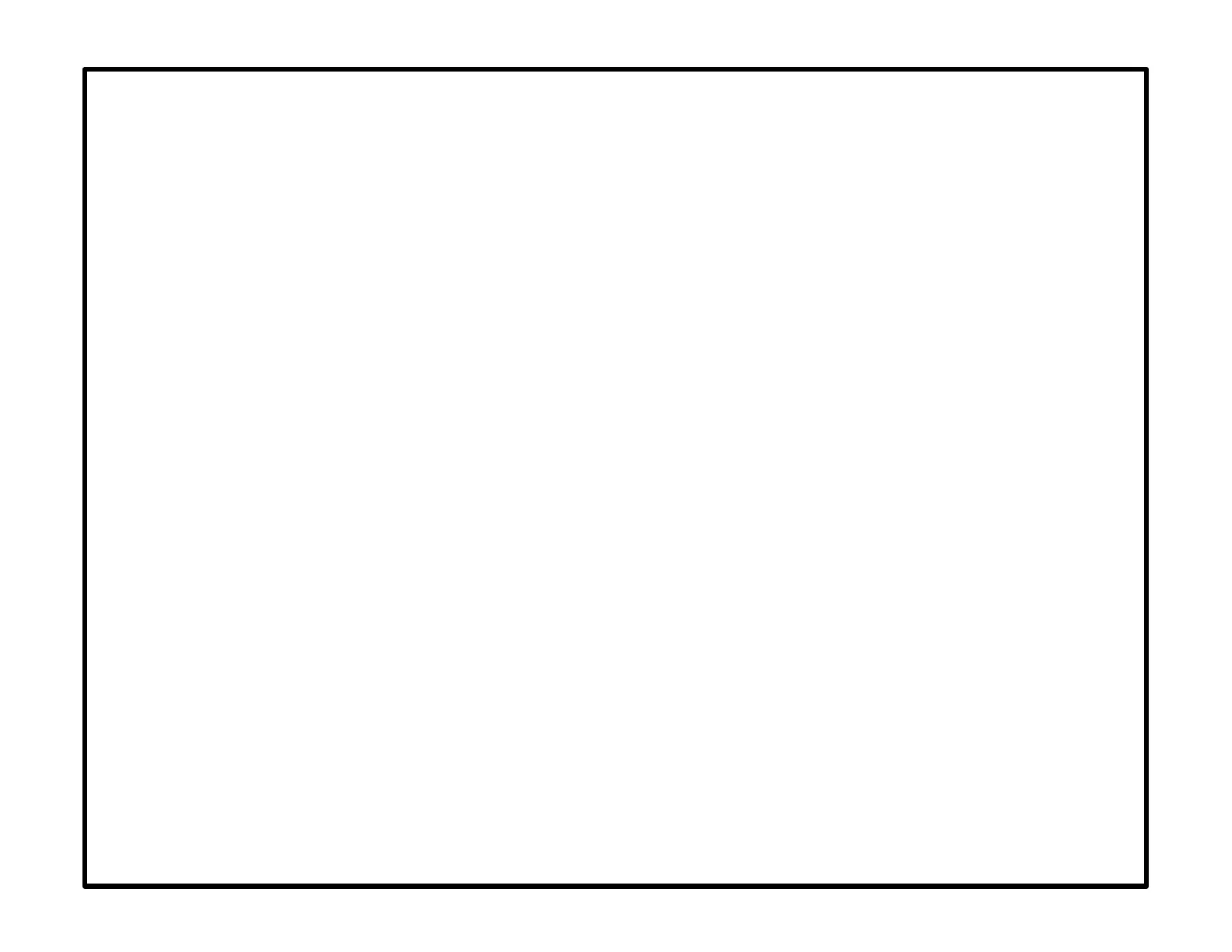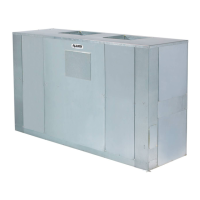Page 107
C4 or C6 DIAGRAM WITH D8 DIAGRAM
Flexstat or Prostat with Three-position Economizer and Warm-up
4- C4 or C6 Section with D8 Section
Optional Flexstat or Prostat programmable thermostat allows GCS16 units to automatically
setback setpoints for unoccupied periods as well as control setpoints more precisely than
electromechanical thermostats. With economizer and warm-up kit added, both are capable of
directly controlling operation of outdoor air dampers. Warm-up kit applied to the economizer
holds the outdoor air dampers full closed while warming the building after being setback for an
unoccupied period.
NOTE - In order to understand how these optional controls affect the operation of the GCS16,
you must first understand how all GCS16 components work. Refer to the basic unit operation
operation sequence.
NOTE - These thermostats have a built-in clock for controlling setback. Optional time clock
CMC3-1, night thermostat and night relay kit are not needed and are not compatible.
WARNING - CONNECT ONLY RELAY KITS DESIGNED FOR THIS CONTROL SYSTEM.
RELAY KITS DESIGNED FOR OTHER CONTROL SYSTEMS ARE NOT COMPATIBLE
AND CONTROL DAMAGE OR FAILURE WILL RESULT. FOR EXAMPLE, NEVER CON
NECT A W973 RELAY KIT TO A FLEXSTAT OR PROSTAT CONTROL SYSTEM.
WARNING - BE CAREFUL TO CONNECT RELAY KITS TO THE PROPER JACK AND
PLUG IN THE GCS16 BLOWER COMPARTMENT. REFER TO WIRING DIAGRAM. IM
PROPER CONNECTION WILL CAUSE CONTROL FAILURE.
Warm-up kit mounts in the control mounting area of the blower compartment (see figure 96).
Some field wiring is required (refer to unit wiring diagram on opposite page). Remove and dis
card jumper plug P3. Warm-up kit harness plug P8 connects directly into jack J3 in blower
compartment. Warm-up kit harness jack J8 connects to economizer harness plug P4. Relay
K42 is not used in this application.
IMPORTANT - Flexstat model L2F has been superseded by Flexstat L2F-N. Terminal desig
nation on the two controls are different. This sequence of operation describes models L2F-N.
Refer to Table 23 for more information.
NOTE - Flexstats ONLY: If slide switch number 7 on back of model L2F-N (slide switch num
ber 5 on back of L2F) is switched to ON position, the blower operates continuously during
occupied periods and automatically cycles during unoccupied periods. If this slide switch is
switched to OFF position, the blower operates normally during unoccupied periods, con
trolled by the ON/AUTO button on the face of the control.
Operation Sequence:
1- Economizer outdoor air dampers drive full closed anytime blower B3 is not operating. Damp
ers also close during unoccupied periods and during morning warm-up. Outdoor dampers
open to minimum (mid) position during all other unit operation.
2- Economizer relay K11 (not shown) is not used in this application (not furnished).
3- Flexstat and Prostat are designed so that the fan switch in the thermostat is to be left in the ON
mode at all times. This allows the blower to be controlled by terminal 4 inside the Flexstat (G in
Prostat). The blower operates continuously during occupied periods and intermittently (only
during demand) during unoccupied periods.
4- During a heating demand when the building is not occupied, the blower is activated only when
a heating demand passes through relay K25 in the GCS16. During a cooling demand when the
building is not occupied, the blower is activated through terminal 4 in the Flexstat (G in Pros
tat).
First Occupied Heating Demand of the Day (Morning Warm-Up):
5- Initial heating demand (Prostat terminal W1 - Flexstat terminal 4) activates the heating section
of the GCS16 directly and relay K40.
6- Contacts K40-1 open to keep relay K41 de-energized. Contacts K41-3 remain open to keep
outdoor air dampers closed during initial heating demand.
7- When heating demand is satisfied, unit gas valve and relay K40 are deenergized.
8- Contacts K40-1 close. Contacts K42-1 are closed (not used in this application).
9- Time delay DL7 begins a 30 second count before closing.
10- If a second heat demand reaches relay K40 within 30 seconds, contacts K40-1 open, time
delay DL7 loses power and resets and the economizer is locked out for the second heating
demand. Steps 5-10 repeat. Outdoor air dampers remain closed.
11- If a second heat demand does not reach relay K40 within 30 seconds, time delay DL7 closes,
relay K41 energizes and contacts K41-1 and K41-3 close to lock in economizer for the day
(until blower B3 stops). Outdoor air dampers open to (mid) minimum position during blower B3
operation. Outdoor air dampers close when blower B3 is not operating.
Occupied (Day) Cooling:
12- When thermostat switches to occupied (day) mode, blower B3 is energized in continuous
mode through unit terminal strip terminal TB1-G.
13- Terminal TB1-G also routes power through contacts K40-1 and K42-1 to time delay DL7. Time
delay DL7 begins a 30 second count before closing.
14- After 30 sec.,time delay DL7 closes to allow relay K41 to energize.
15- When relay K41 energizes, contacts K41-1 close to lock in economizer until blower stops
(night setback). Contacts K41-3 close to allow power to economizer.
Cooling Demand Enthalpy Low:
16- Enthalpy control internal relays switch to close a circuit from 1k terminal 1 to 6 and from 2K
terminal 3 to 5.
17- Initial cooling demand (Prostat terminal Y1 - Flexstat terminal 5) is routed through enthalpy
control terminals 1 and 6 and through discharge air thermostat S13 to energize enthalpy con
trol terminal D and damper motor terminal D. 24VAC applied between damper motor terminals
D and T energizes the damper motor and the outdoor air dampers open fully.
18- Economizer outdoor air dampers drive full open during blower B3 operation (anytime there is a
cooling demand)to provide 1st stage cooling. Outdoor air dampers drive full closed anytime
blower B3 is not operating.
19- Additional cooling demand (Prostat terminal Y2 - Flexstat terminal 7) is routed through enthal
py control terminals 1 and 2 to energize the compressor. The compressor provides all addi
tional cooling.
Cooling Demand Enthalpy High:
20- Enthalpy control internal relays switch to close a circuit from 1k terminal 1 to 2 and from 2K
terminal 3 to 4. Outdoor air dampers close. Dampers open to minimum position during blower
operation.
21- Cooling demand (Prostat terminal Y1 - Flexstat terminal 5) is routed through enthalpy control
terminals 1 and 2 and terminal 5 to energize the compressor. The compressor handles all cool
ing demand.
22- Blower demand (Prostat terminal G - Flexstat terminal 4) energizes blower relay K3 in the unit.
Contacts K3-1 close to energize the blower and contacts K3-2 close to energize the econo
mizer. When 24VAC is applied between enthalpy control terminals X and T, the outdoor air
dampers open to mid (minimum) position. Dampers remain open when blower B3 is operating
and close when B3 is not operating.
23- Increased cooling demand (Prostat terminal Y2 - Flexstat terminal 7) not used.
Unoccupied (Night) Operation:
24- Flexstat terminal 4 de-energizes. Blower B3 is de-energized and relay K41 is de-energized.
Time delay DL7 opens and resets. Outdoor dampers drive full closed.
25- When relay K41 de-energizes, contacts K41-1 open to unlatch relay K41 circuit. Contacts
K41-3 open to lock out economizer operation during unoccupied period.
26- Unoccupied heating demand W1 energizes relay K40 and GCS16 heat section. Contacts
K40-1 open to unlatch relay K41 circuit (operates like morning warm-up).

